Some of the links in this post may be affiliate links.
Rhaphidophora tetrasperma is in huge demand, and for good reason. It’s a rapid grower, propagates easily, and is easy to care for with no special requirements. In this post, I highlight 5 basic tips on how to care for this amazing houseplant soo it thrives under you care, along with an illustrated guide on propagation.
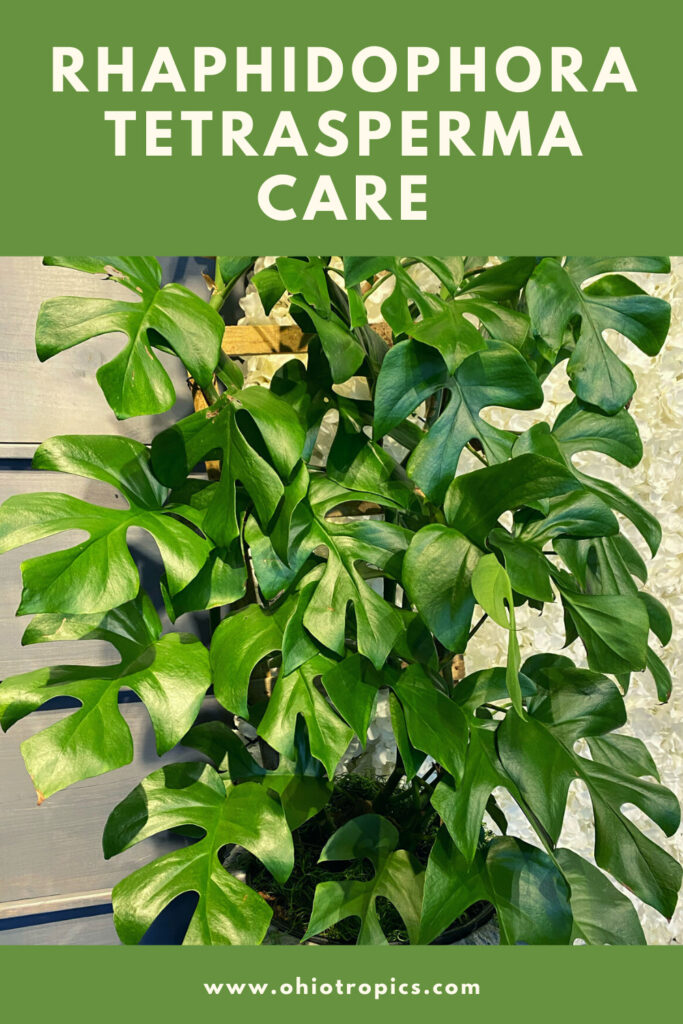
Table of Contents
RHAPHIDOPHORA VS. MONSTERA VS. PHILODENDRON
First of all, I wanted to briefly talk about all the crazy common names that have cropped up for this plant, which has caused a lot of confusion.
Rhaphidophora tetrasperma is sometimes called mini monstera or dwarf monstera because it looks like a miniature version of Monstera deliciosa. Other common names include Monstera ‘Ginny’ and Philodendron ‘Ginny’ but these names are all misleading.
I’ve even seen it advertised as Monstera minima but this is incorrect. Although Monstera, Philodendron and Rhaphidophora are in the aroid plant family (Araceae), each one is a distinct genus.
So to be completely correct, this plant is a Rhaphidophora tetrasperma! (Rhaphidophora is the genus and tetrasperma is the species.) It is not a Monstera and it is not a Philodendron.
According to the International Aroid Society, Rhaphidophora tetrasperma is considered rare in nature. But fortunately for us, the plants grow very rapidly and are easy to grow!
It is native to limited areas in southern Thailand and parts of Malaysia, and was discovered in the late 1800s.
If you like Monstera deliciosa but you don’t have enough room, Rhaphidophora tetrasperma is a great option. It has a similar flair but on a smaller scale.
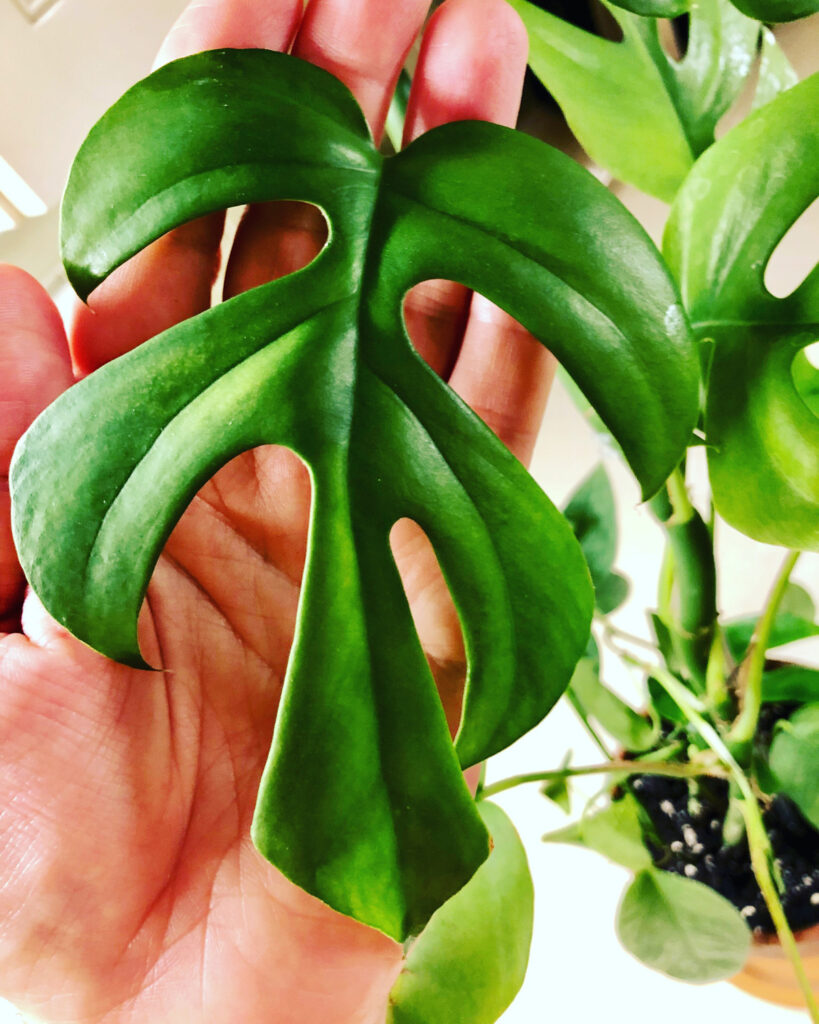
This plant used to be hard to find, but it is becoming much more common. I really believe that they will become very widespread one day, similar to Pilea peperomioides. (They used to be scarce and expensive, and now they are much more common and very inexpensive.) r
RHAPHIDOPHORA TETRASPERMA CARE
1. LIGHT
Give your Rhaphidophora bright indirect light. These plants don’t like a lot of direct sun, but some is fine.
I have mine growing in my sunroom and it front of a northern exposure window, but it is also close to an Eastern exposure window and will get a little morning sun.
Be cautious of too much sun, especially if it is afternoon direct sun which can be too much for this plant. You can keep it near Western or Southern exposure windows too, but be sure to diffuse the light, or set them back slightly from the window, as they don’t like being in too much direct sun all day.
This is not a low light plant so please give it good light otherwise you will be disappointed with poor growth and small foliage.
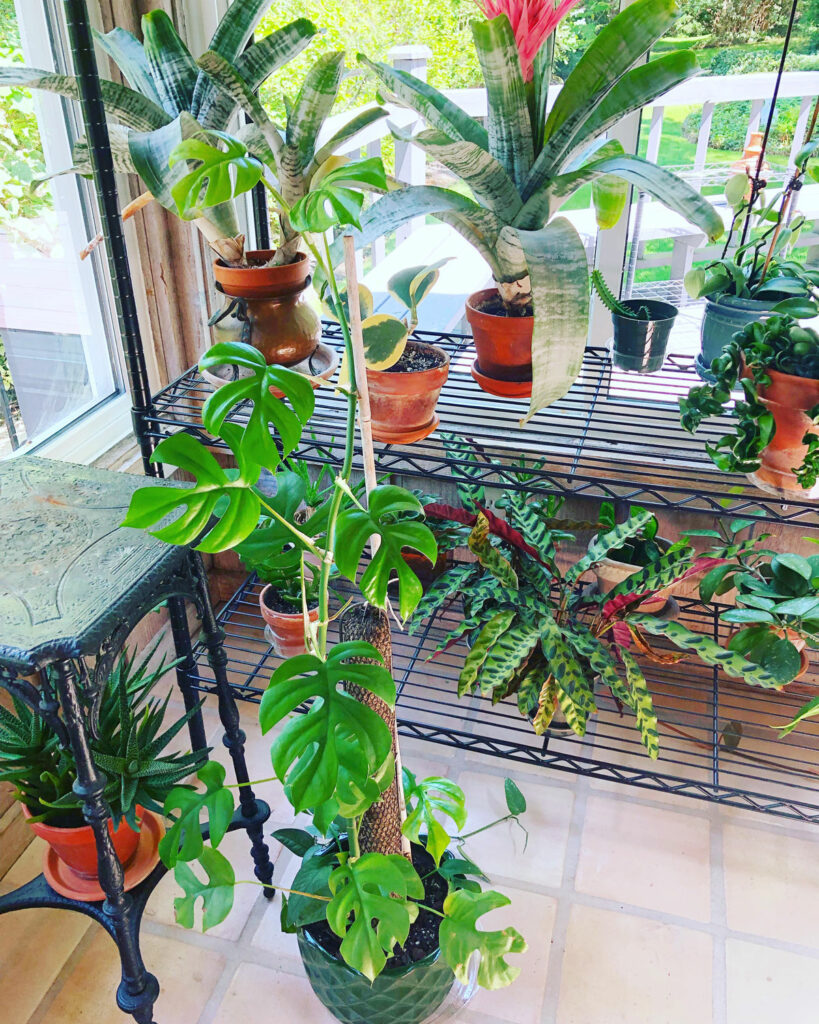
2. WATER
Try and keep this plant fairly moist, but not waterlogged.
These plants do not like to go completely dry so pay attention to it if you want the best growth out of your Rhaphidophora! More important tips on moisture requirements in the section below.
I always recommend watering your plants thoroughly, letting water drain out of the drainage hole, and waiting until the top inch or so of the potting mix is dry before watering again.
These plants do NOT like to go completely dry so try not to let this happen. You will notice that the lower leaves will turn yellow if you let this happen.
My own plant’s growth slowed down quite a bit during the darker winter months, and the soil took longer to dry out, so be aware of this. Always feel the soil to know when to water your plant. Don’t follow a “once a week” watering schedule blindly!
Water when it is needed, and not when your schedule tells you too. In addition, I highly advise against using a moisture meter. Many of my clients have struggled with them, to the point where I wrote a blog post on the dangers of moisture meters.
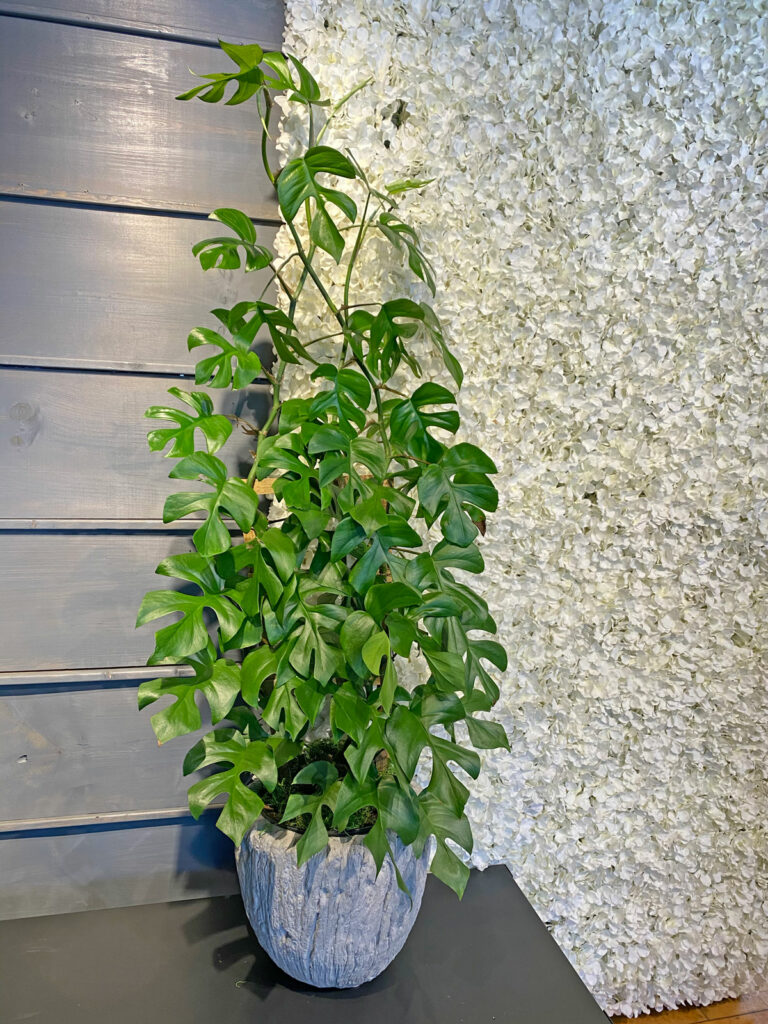
3. POTTING MIX & POTS
When I first rooted my first cutting of Rhaphidophora tetrasperma, I planted it an all-purpose potting mix that I had on hand and planted it in a small terra cotta pot.
The terra cotta pot was not the ideal pot choice by any means. Sometimes I just use what I have on hand, out of laziness, but I would not recommend using terra cotta pots for this plant.
Perhaps a larger terra cotta pot would have been fine, but small terra cotta pots dry out much too quickly.
Like I mentioned earlier, these plants hate to dry out too much. I would recommend using either a heavier plastic pot, or a nice glazed ceramic pot.
A heavier, sturdy pot is ideal because this plant will need a support post, so you don’t want your plant to be toppling over. I’ll get into adding a support later in this post.
As far as potting mix, I was able to find a useful piece of advice from Exotic Rainforest that pointed out a Rhaphidophora tetrasperma enthusiast that used the following potting mix.
No specific ratios were mentioned, but I’m following that one recommendation. Here is my mixture. It is a very well drained soil and I’m using the following components:
To which I’ve added some orchid potting mix.
And a bit of activated charcoal was added.
The potting mix should be kept constantly damp.
Notice that I said damp and not wet! To be safe though, I would still wait until at least the surface is dry to the touch before watering again. Avoid letting this plant go completely dry at all cost because it will protest.
Please note that if you add chunky material like the orchid bark, the potting mix will be very aerated and you won’t have to worry nearly as much about overwatering since much more oxygen will be available at the roots.
As I lived with this plant and continued to propagate and grow it, I’ve found that just a plain blend of an all-purpose potting mix (3 parts) mixed with perlite (1 part) also works very well. No need to get fancy with potting mixes.
4. FERTILIZER
My taste in fertilizer has continued to evolve and I have switched my all-purpose fertilizer to a product called Dyna-Gro Grow.
This is a very high quality fertilizer for a number of reasons.
It is a complete fertilizer and it supplies all the necessary macro and micro nutrients that plants need. Eventually if you use a fertilizer that is not a complete fertilizer, it may eventually suffer from nutrient deficiencies.
Micronutrients, although needed in very small amounts, are still necessary to plant growth.
None of the ingredients in this fertilizer contain Urea, which can harm plants over time. Many cheaper fertilizers use Urea, and some of them in large quantities.
A good fertilizer will make the difference between a mediocre plant and a spectacular plant (provided your other aspects of care are up to par!)
So although Dyna-Gro Grow may cost a bit more than many of the more commonly available fertilizers, my plants and your plants deserve it! I’ve experienced amazing growth with consistent use of this fertilizer.
5. CLIMBING SUPPORT
In order to get the best growth possible out of your Rhaphidophora tetrasperma, you must give it a sturdy, climbing support.
I grew my initial plant from a cutting that friend sent me. I will describe how I rooted my Rhaphidophora in the next section.
I initially gave my first plant a support which consisted of a thin bamboo stake, but it quickly outgrew it.
Here are two easy options to support your plant.
BAMBOO TEE-PEE
The easiest, and best way in my opinion, is to make a bamboo tee-pee. Simply insert 3 bamboo canes in your pot and tie them on top. As the plant grows, simply continue to secure the plant with plastic clips, garden twine, or whatever you have handy.
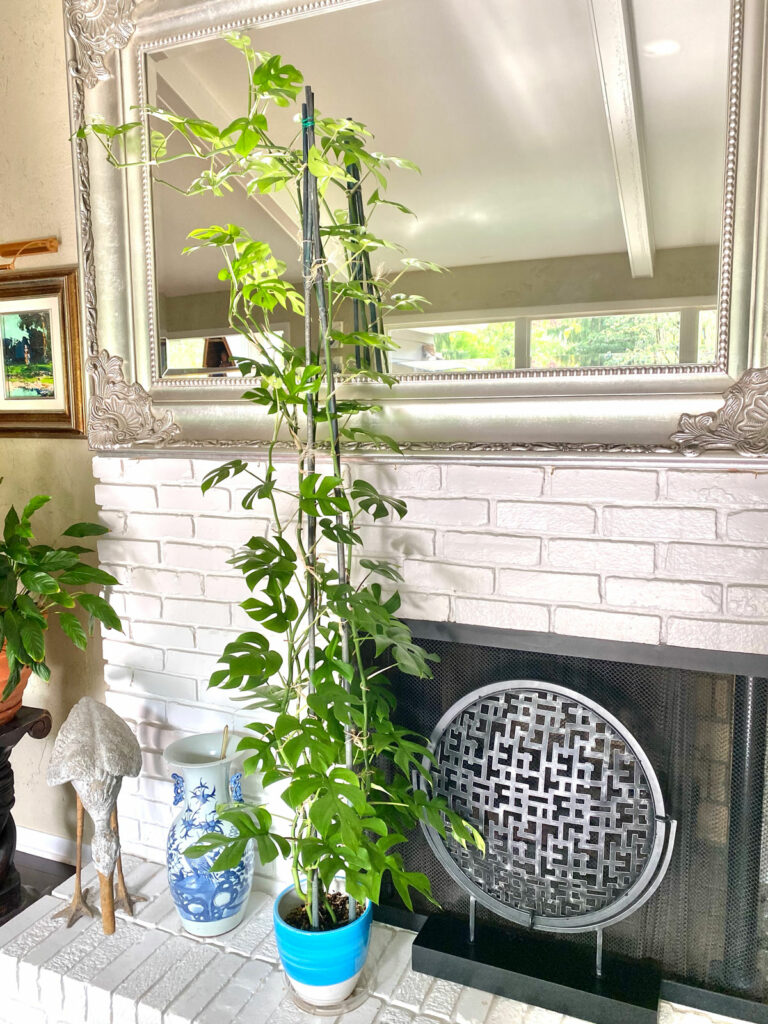
MOSS POST
The second way that I would recommend supporting your plant is using a moss post. This is much more work, but the results can be beautiful.
If you would like to make your own (and I promise you it will be much better and cheaper than anything you can purchase), check out my blog post with step-by-step photos and instructions on making your own moss post.
6. TEMPERATURE
This is a warm growing tropical plant, so keep temperatures on the warm side. If you move your plants outdoors during warmer weather, wait until night time temperatures are consistently 55F (13C) or higher.
Growth will be best in warm temperatures. 55-85F is a good range to keep in mind.
7. HUMIDITY
I always say that if you can keep your potting mix at a good moisture level for your plant, it is much more important than trying to
The most practical way to
If you would like to see my recommendations, check out my top 3 humidifier post to help you make your decision.
RHAPHIDOPHORA PROPAGATION
It helps to have crazy plant friends to send you cuttings of interesting plants! One of my friends sent me a single cutting of Rhaphidophora tetrasperma, and from that cutting,I’ve propagated and grown more plants than I know what to do with.
After surviving being mailed to me, the cutting grew roots for me very easily in water. I started out with one cutting that had 3 or 4 leaves on it.
If you are trying to propagate Rhaphidophora tetrasperma, just be sure to include at least one node under the surface of the water in your propagation vessel.
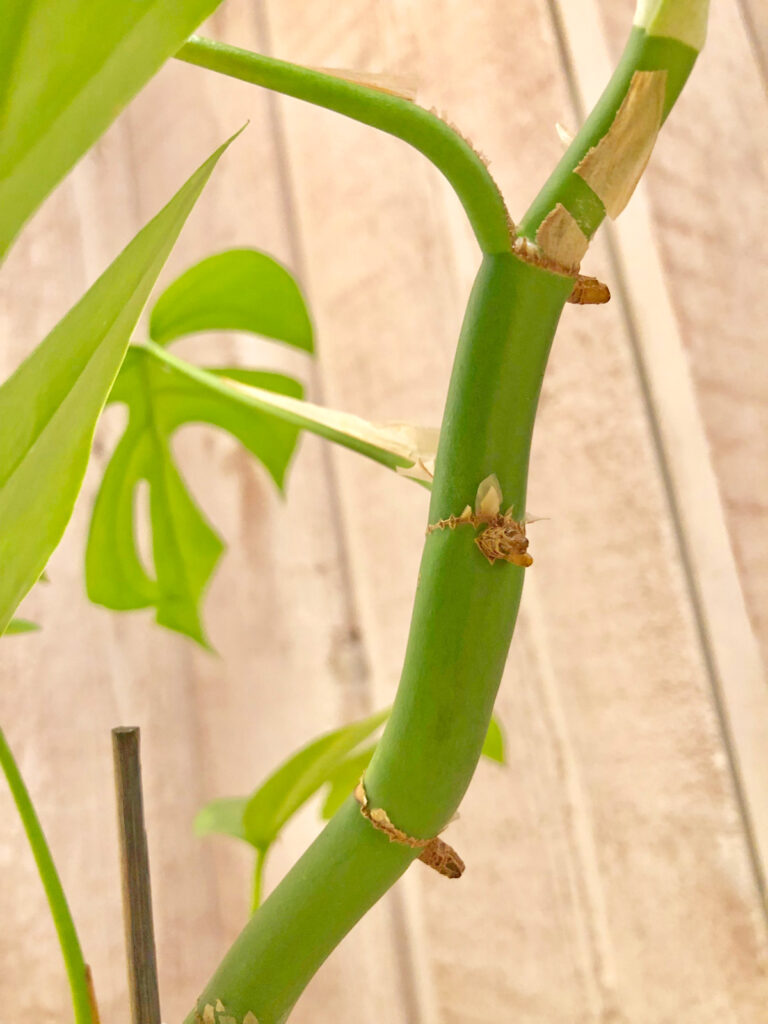
The nodes are simply the portion where the leaf meets the stem. There are where the roots will grow from. You can see the aerial roots already along the stem in the photo above.
Just cut below one of these nodes, and place at least one of the nodes under water and wait for them to root.
In general, when I water propagate any plant, I wait until the roots are 1-2 inches long and then I will pot them up in soil.
Of course sometimes I get lazy and let the cuttings go way too long, like the cuttings below that I took all from a single stem of my plant:
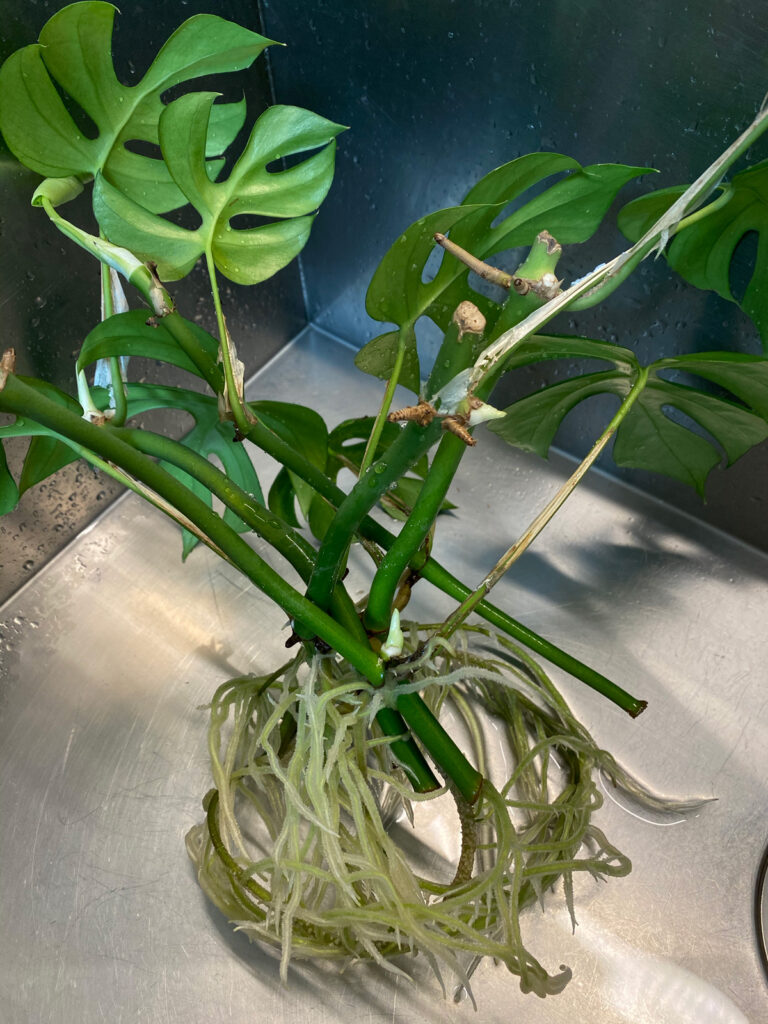
This created more work because then I needed to detangle these cuttings before I potted them up. And WOW, the roots were strong and thick!
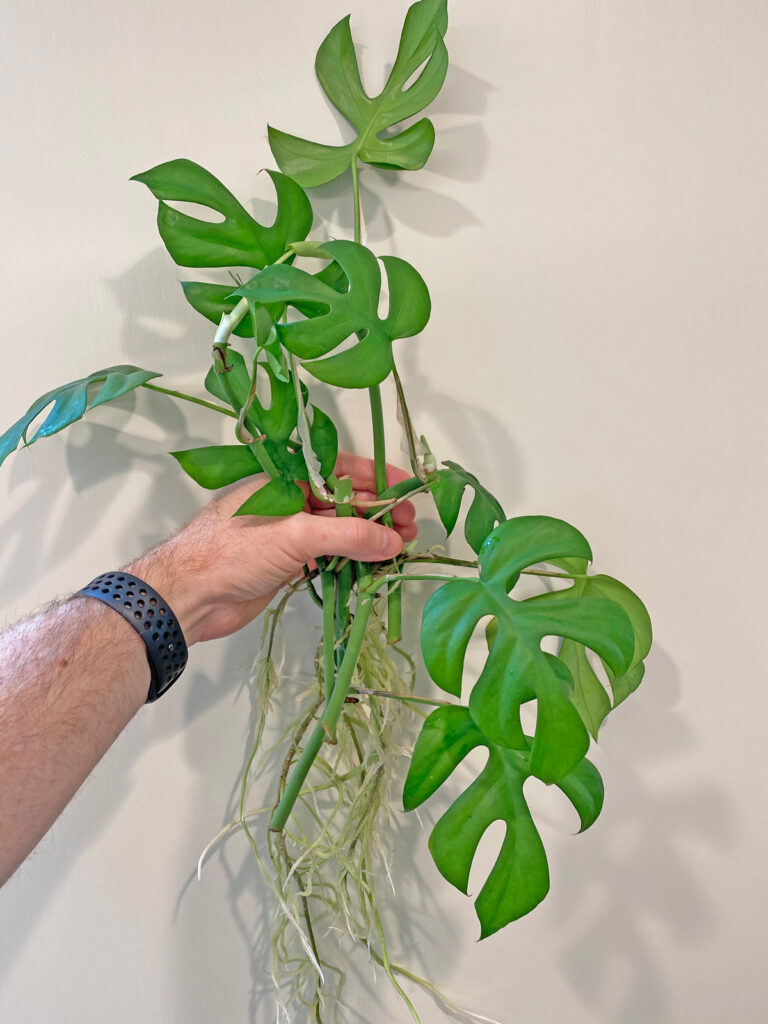
The cuttings themselves were starting to grow in the water, as you can see from the buds forming in the photo below. Ideally, just wait until the roots are 1-2 inches long and then pot up in soil if you can!
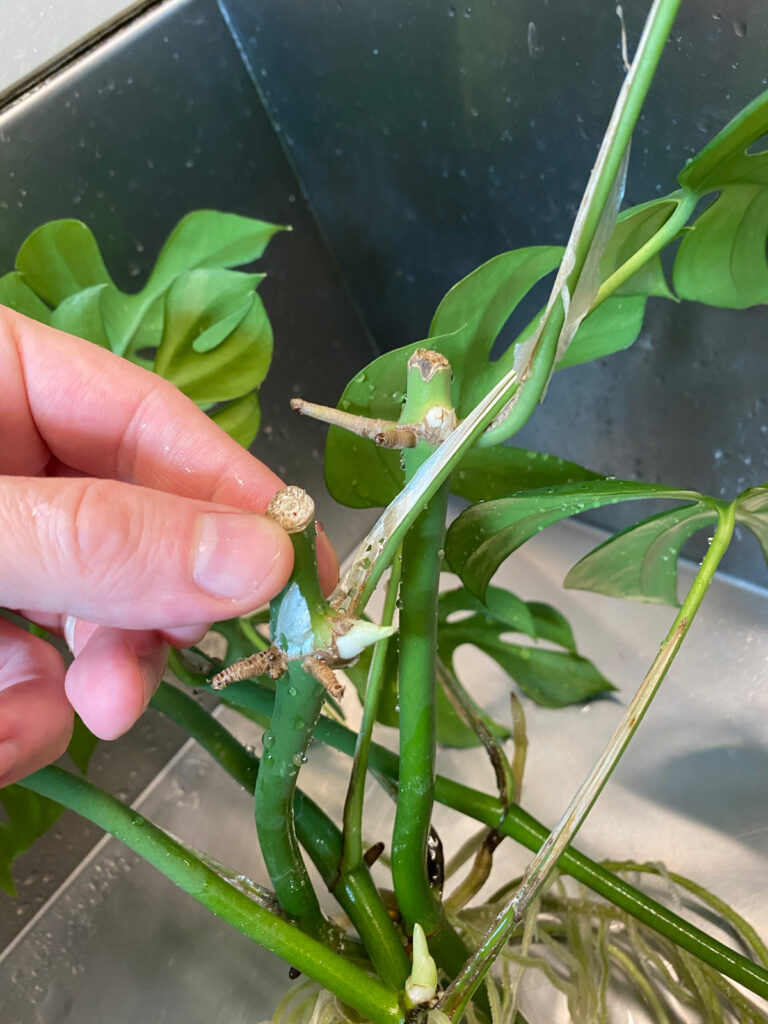
Now let’s take a look at what these cuttings turned into after 1 year.
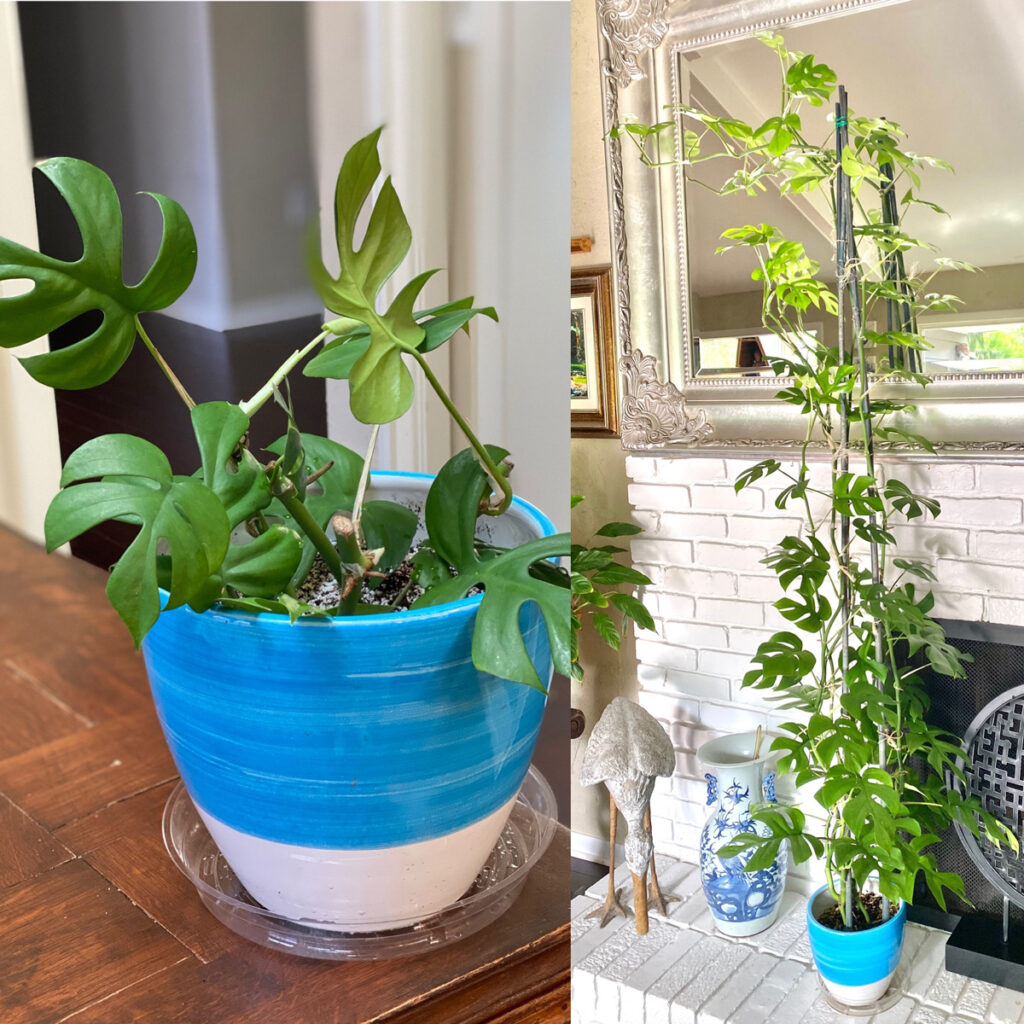
Right: April 2021
Look at the transformation after just 1 year!
If you enjoy water propagation, be sure not to miss my post on the best houseplants to propagate in water.
COMMON PROBLEMS AND QUESTIONS
Why is my Rhaphidophora tetrasperma getting yellow leaves?
There are many reasons why plants can get yellow leaves. The most common reason is imbalances in soil moisture. If your soil has gone completely dry, your plant will develop yellow leaves on the lower part of the plant. On the other hand, if your plant stays soggy for a long time, this can also result in yellow leaves. Feel your potting mix to determine what happened and adjust your care accordingly.
Is Rhaphidophora tetrasperma toxic?
Like any member of the Araceae (aroid) plant family, Rhaphidophora contains insoluble calcium oxalate which is toxic to pets and humans if ingested.
Why does my Rhaphidophora tetrasperma have brown spots?
You could potentially have a bacterial or fungal infection. Isolate your plant and treat with an appropriate fungicide.
Why does my Rhaphidophora tetrasperma have droopy leaves?
This is likely caused by a soil moisture issue. Potting mix that has gone too dry (or even too wet to the point of root rot) will both cause droopy leaves. Try and aim for a good balance in soil moisture.
When will my Rhaphidophora tetrasperma get fenestration?
This is highly dependent on the age of your plant and the quality of your growing conditions.
What is Rhaphidophora tetrasperma growth rate?
This is a rapidly growing plant if you can provide good growing conditions. I’ve had my plants grow over 6 feet in a single year.
How big does Rhaphidophora tetrasperma get?
This plant can easily get several feet tall even indoors. Plants can get up to 5m tall in the wild.
Why is my Rhaphidophora tetrasperma’s leaves curling?
Like many plant woes, there can be multiple reasons why this is occurring. Soil that is too dry or too wet can cause this, as can drafty areas (too cold or too hot), as well as very low humidity.
Have you tried looking for a Rhaphidophora tetrasperma? They seem to be sold out everywhere online! Hopefully in the near future, they will be more abundant, and cheaper as well.
Rhaphidophora tetrasperma is definitely a fantastic houseplant and is surprisingly easy to grow.
And if you follow all the recommendations I’ve made in this post , you will be shocked at quickly these plants grow!


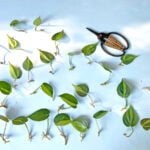


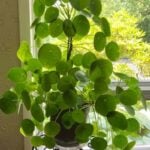

Nabila
Friday 19th of July 2024
Hello ! Thanks for all the informative articles on the web site. i bought some cuttings at the beginning of spring not knowing what i was bying exaclty. it was pretty and i wanted new plants.
And i think i got a raphidophora tetrasperma but i have some doubts since only 2 leaves have fenestrations. it grew like crazy, the foliage is thick, but there is zero fenestration on the new leaves.
i know it's normal when they're young thanks to your article, but i can't find any picture of young raphidophora tetrasperma to compare with mine and be sure it's ok.
i also got a growing light, so from now on patience is key.
here's my question : when every thing is fine, how long after repoting a cuting should we expect fenestrations ?
thank you so much for your time !
Raffaele Di Lallo
Thursday 25th of July 2024
Hi Nabila! You're very welcome! The time can vary drastically depending on the growing conditions. It's hard to say since we don't know how old your plant is...like you said, just have patience, and you will get fenestrations soon enough :-)
Tremblaw1024@gmail.com
Sunday 18th of September 2022
Hello, my plant is now easily over 6’ tall and I am wanting to propagate to make it more “full” with multiple stems (it currently is one tall stem). My question is about where to cut and how many times I can cut. Do I want to cut with a few nodules and can I cut a couple times from the top, or do I cut once and wait and then cut from the top again? Does that make sense?
Raffaele
Monday 19th of September 2022
That's the nature of how these plants grow. If you want a bushier plant, I would just take a few single node cuttings, root them, and then plant them back in the same pot. If you need a bigger pot, you can put everything into that pot all at once. The original plant will regrow from where you cut it, but it may not form more than one growth. It will grow at least one for sure. But it sounds like you want a bushy plant, so I'd probably a few cuttings and plant them together.
Charlotte
Sunday 16th of January 2022
I’m thinking of propagating one of mine since I’m trying to save it from root rot and I’m thinking I should probably propagate a cutting just incase things go downhill. However, I’m just wondering will the plant grow back from where the cutting has been taken? Thanks
Raffaele
Monday 17th of January 2022
Hi Charlotte! Yes, the original plant will grow back as long as you leave at least 1 node on the stem.
Aggie Hufnagel
Friday 13th of August 2021
Thank you for the monsters propagation tips, will the original plant grow again?
Raffaele
Friday 13th of August 2021
You're very welcome Aggie! Yes, the original plant will grow back.
Heidi
Monday 12th of July 2021
Thanks for the in depth article! I am wondering what happens to the plant where you take the cutting. Will it regrow or branch from that point? Thanks much!
Raffaele
Monday 12th of July 2021
Hi Heidi, you're very welcome! Yes, your plant will grow back after you take a cutting :-).